
EMPLOYEE SPOTLIGHT: A WORTZ
05/14/21 — Ada Broussard
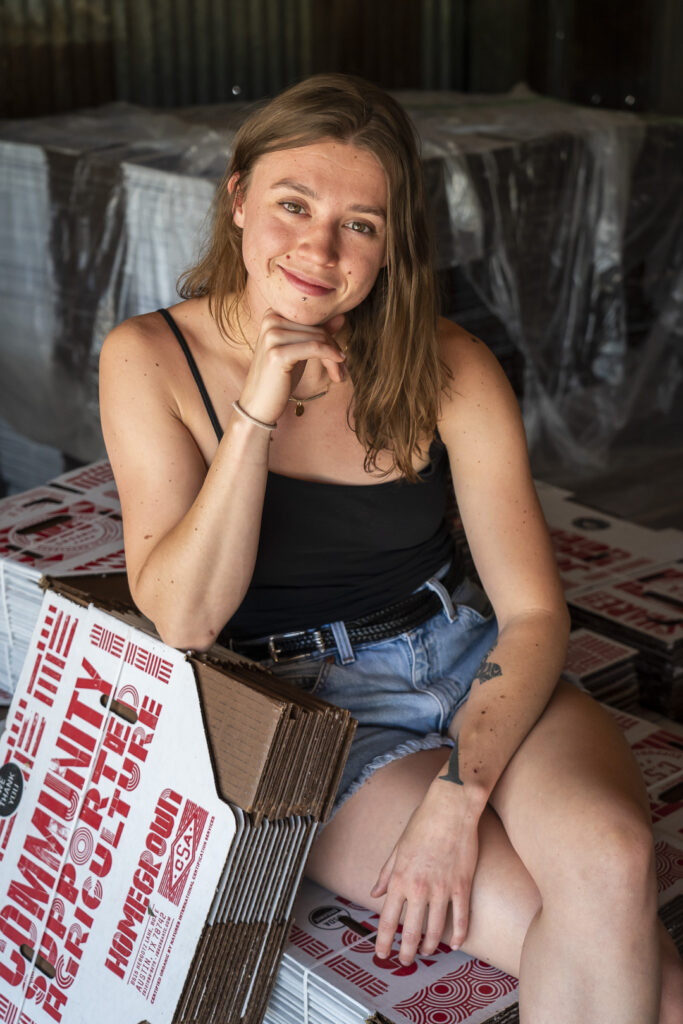 Ladies and Gents, A Wortz!
Ladies and Gents, A Wortz!
The JBG fields span around 184 acres, and we grow hundreds of thousands of pounds of organic produce annually. We’re so proud to operate one of the largest true CSA programs in Texas, with over 2,000 members who have partnered up with us, incorporating our farm’s produce into their weekly meals. There are nearly 100 full time employees who keep things going from seed to sale, yet despite these grandiose numbers and the perceived scale of JBG, there is just one person who sits at the head of all-things customer service: A Wortz!
If you’ve ever emailed the main farm email, given the office a ring, stopped by our mobile home headquarters, complained about a less-than bunch of kale, alerted us about a late delivery, you’ve likely met A, officially our “CSA Coordinator”, and unofficially the motor that keeps it all going. A is the bridge, strong and steadfast, that connects our CSA Customers with our Farm Staff. She’s got a pulse on people’s beet fatigue, and cares deeply about the quality of the service we provide - not just the vegetables, but also the timeliness of deliveries and the functionality of our website. And if that weren’t enough, she also helps Krishna with bi-weekly payroll, coordinates delivery logistics, makes sure the office is running smoothly, and keeps everybody in the loop re birthdays and work anniversaries.
It’s been quite some time since we’ve done an employee spotlight (like this one of Lucas, Tracy, Scott, Lyndsie, and the Delivery Drivers), and we can’t think of a better person to kick things off again. A, thank you for the hawk-like eye you keep over our CSA and CSA Members. The Chronicle recently named us Austin’s best Monthly Subscription Box Service (yay!! We’re honored!), and there is no doubt that your hard work, creativity, and care are a central ingredient to keeping the CSA so vibrant. Without further ado, an interview with A. (And yes, that’s her whole name! You’re not missing any letters.)
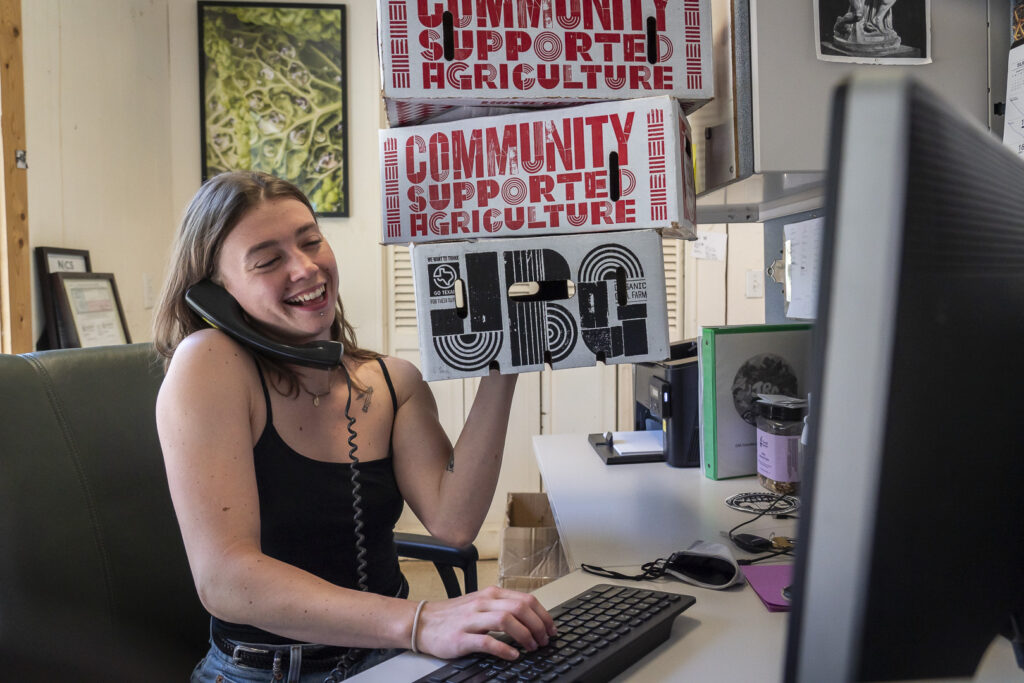 A truly juggles it all! Phones, emails, driver logistics, hr.... empty stacks of CSA boxes. Photo by Scott.
A truly juggles it all! Phones, emails, driver logistics, hr.... empty stacks of CSA boxes. Photo by Scott.
A! Tell me, how’d you get to Austin?
I grew up in Kansas... like rural Kansas in the middle of nowhere. I lived for 18 years in the same house, and when I graduated from high school, I knew I wanted to get out and see more of the world. I ended up moving to Syracuse, New York and attended Syracuse University. And every summer during college, I would live in a different place. Once I graduated, I realized the extreme cold in upstate New York was not for me… so I moved to Austin, Texas. That was in May of 2018… 3 years now!
Austin’s climate sounds like it was a big factor?
Weather is huge for me. I lived in Sacramento for a summer. I lived in Portland for a summer. I’ve spent a lot of time in San Francisco and I lived in LA for a brief period. To me, it just seems like most large cities offer a lot of the same things, and so the deciding factor for me is the weather.
So you found your way to Austin. How did you find JBG?
There for a while I was working in the service industry, and I worked at a few different restaurants and our cooks would usually wear a JBG hat. And I would just see them around town... they were just so iconic, and I’d see a van pop up every now and then. And I couldn’t help but think, like, “wow, this must be such a cool company! The branding is so dope. I don’t really know what they do or who they are… but I’m interested.’ Once I started working at Bento Picnic, they were a regular purveyor of ours, and so we would see the driver every few days. That’s when I got to understand what JBG was. And after I lost my job during the pandemic, this administrative position opened up and I jumped on it.
What other restaurants did you work at besides Bento Picnic?
I was working mostly at Brewer’s Table, which is now closed up. RIP.
Don’t you have a background in film, too?
Yeah, so, prior to the pandemic, I started my own film festival. I don't know how familiar you are with film festivals, but here's a lot of privilege in the system - a lot of privilege in being in film in general, in receiving funding, and being allowed the position of power to direct the film or take over a story.... Yeah, and that sort of idea is carried out through film festivals as well. There are entry fees to exhibit, and it's mostly one demographic - old white men - judging films and dictating who's good and who's not. At the time, I did production design I had friends who were cinematographers, and my partner at the time was a producer, we were all like: we just enjoy making stuff but we don't have money to send it anywhere, get eyes on it, and was just like, why don't we put something together and we'll all just watch it as a group? So that’s why I put together this festival. We held it twice and so there was no entry fee. Anybody who sent me a film it got put in. And there was always free food and free beer and it was just awesome inviting spaces like, no, no threshold no bar no like anything... just come and be as you are. And so the first one was really just off hand, like all of my friends came and then we invited everybody on social media so like extended friends came. But then the second one, got picked up by Austin Design Week which is like a week long festival highlighting, designers, and we were a featured event at that like community thing and so that got us, we increased by, like, I think it was 300% of attendance and like it was just really cool to give my friends the platform to show their films to people who didn't know us.
That’s so cool. I’m curious how you went from film to farm. I know you said you admired the farm’s branding, but have you ever worked on a vegetable farm before?
Well, growing up in rural Kansas, I was a part of FFA and 4H my entire life. Like, I started as a little Cloverbud at six years old...showing my dogs and making arts and crafts. My mom was also a horticulturist. And so for a while, we had a big garden and in our backyard; one year I won reserve grand champion with some tomatoes that I grew. And so I thought that the agriculture background I had would make me a good fit for this position. Contributing to local agriculture is something that I grew up doing, and I feel like I had not lost my way... but just kind of that piece to the side for a while. When looking for jobs and when this popped up, it felt like a great time to start up again.
What do you do at the farm?
The main focus of my job is customer support, and being the main point of contact for our CSA distribution. So, like being the front face to our 2500 plus member network, and helping them, whether it's changing their box size or helping with quality assurance or just navigating our website… I'm the front runner on those types of things.
Does it feel like a lot of pressure to be one person in front of 2,500?
I mean that it's the best kind of pressure, like I love it. At this point, people know who I am. It's so cool to have a rapport with a lot of our customers.
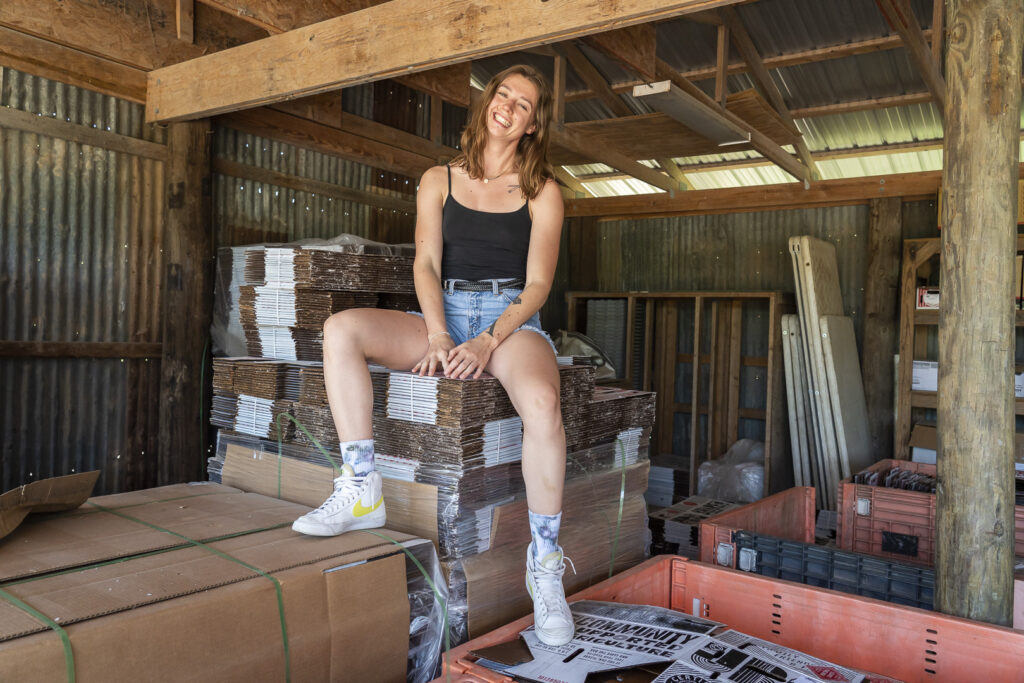 A amid the pallets of CSA boxes. Nothing better to break up the work day than a photoshoot in the pole barn!
A amid the pallets of CSA boxes. Nothing better to break up the work day than a photoshoot in the pole barn!
I assume that there's some customers that you talk to every week and know well, and others that maybe never need to get in touch?
Totally. Also, anytime someone emails me whether it's like every week or a one off thing, if they have a website or social media and their sign off, like I like to get to know them better through how they like portray themselves online and I think it's really cool to to use that and know who our members are and just like appreciate their work.
How would you describe our CSA membership?
All of our customers are just so caring... not only our farm, but also about sustainability and the environment as a whole, as well as just thinking about their own health and how that contributes to the greater society. Our customers are really really insightful and thoughtful. Aside from that, we also have a lot of creative customers… like a bunch of designers and craftsmen are some of our longtime members and I think that's really cool too.
What’s your favorite part about your job?
I am a low key workaholic, and so my favorite part of the job is that it never stops. I love that there's this big network and I am in charge of taking care of everyone within it… I just enjoy that responsibility and find a lot of joy in the position because of it.
You started this job in the middle of a pandemic, and recently, you helped the farm navigate the aftermath of the ice storm which wiped out the majority of our crops. Talk to me about that!
I feel like things here are always in flux… we’re a farm. The two biggest things that I saw from those experiences were that our members really care about our farm. It’s so great that folks step forward, not only with extending their memberships, but also with donating to our employee wellness fund. Even though we lost a a solid chunk of members through the time where we weren't using our own vegetables, there were so many people who said, like, “I get it, I know what's going on I'm here with you... you can't get rid of us. We love this so much, and we're here to stay.’ That was really cool to experience, just how devoted everyone is. Also, our staff… we all just rode that snowstorm on snowboards. We were just coasting. Like, we’re gonna do it, we’re gonna make it happen. Everyone's just so talented here, and it was a great team effort. I don't know what we would do without Krishna.
I agree about the team - what a strong farm crew we have! Speaking of - talk to me about who you’re working with in your day to day at the farm.
I feel like I talk to everybody who works here at the Hergotz location! work with Andrew, because he's the head CSA packing manager and is directly packing the boxes. So we're talking about quality, we're talking about box contents, we're talking about what members want in their box, what they want out, we're talking about marketing things, like how to get more members.. I'm working with all of our drivers because I do all of their delivery paperwork as well as create the routes, and handle any discrepancies that happen while they're out and about. I work with Mike, our Restaurant Sales Manager, specifically with the drivers as well, to make sure our drivers are fully up to speed on what's going on that day, as well as field calls for the wholesale or emails when they happen to come into my inbox. I work with Tracy and Brisa when I do HR, when we need to hire more people making sure that the barn crew is fully staffed and then once continuing that HR support with the rest of the barn crew, trying to make sure they're happy and their time cards are up to date.
Favorite vegetable of the moment?
I love curly kale. I eat it almost every day, if not twice a day. Olive oil, salt and pepper, and then scrambled eggs in it. Sometimes with fried potatoes, like a breakfast bowl.
What do you do when you're not at JBG?
Well, I recently built a bed in my car. So I’m often camping… or climbing all the time.
Where do you like to climb?
Some climbers would roll their eyes, I’m totally a gym rat and usually climb at Austin Bouldering Project.
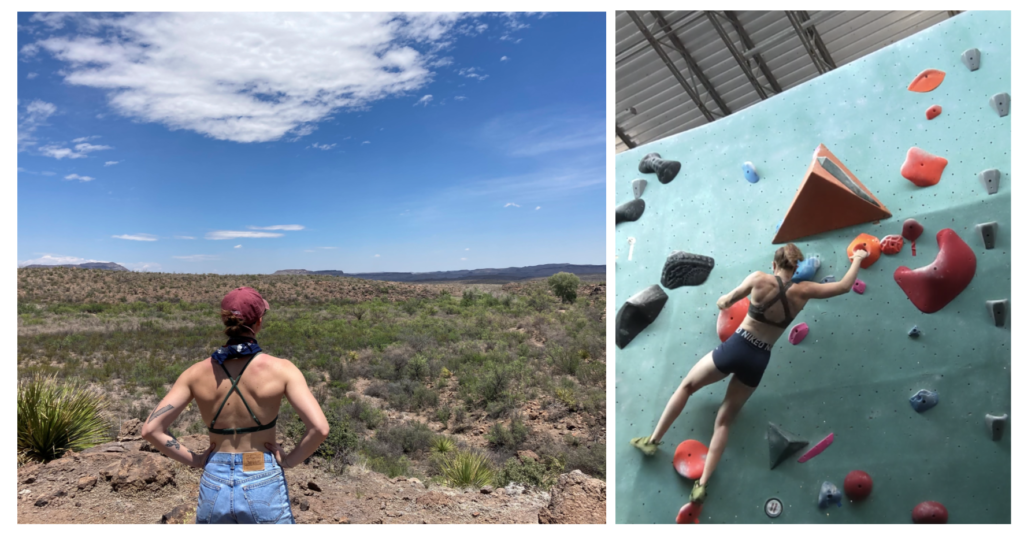 Hiker, climber, CSA extraordinaire!
Hiker, climber, CSA extraordinaire!
That palace is amazing.
Exactly. Yeah, so if I'm not, if I'm not camping or climbing, I'm usually hanging out with my dog and my partner. Ghost is a malamute and he’s actually at the office today looking cute.
 Sweet ghost, enjoying the West Texas views.
Sweet ghost, enjoying the West Texas views.
Any other closing thoughts before we go?
Well, sometimes I do wish that people would understand what, actually, a CSA is. It’s not like a grocery store haul to your door. It’s based on seasonal farm availability, and what we can grow at our farm. Many of our customers get this, but some don’t and expect us to be just like a grocery store. The biggest takeaway that CSA members can have from this experience is that it’s about supporting the farm and being a shareholder in the farm, and I don't know that that's always clear to our members, you know? And the vegetables are actually better than you can find at a grocery store, but not always what you might expect.
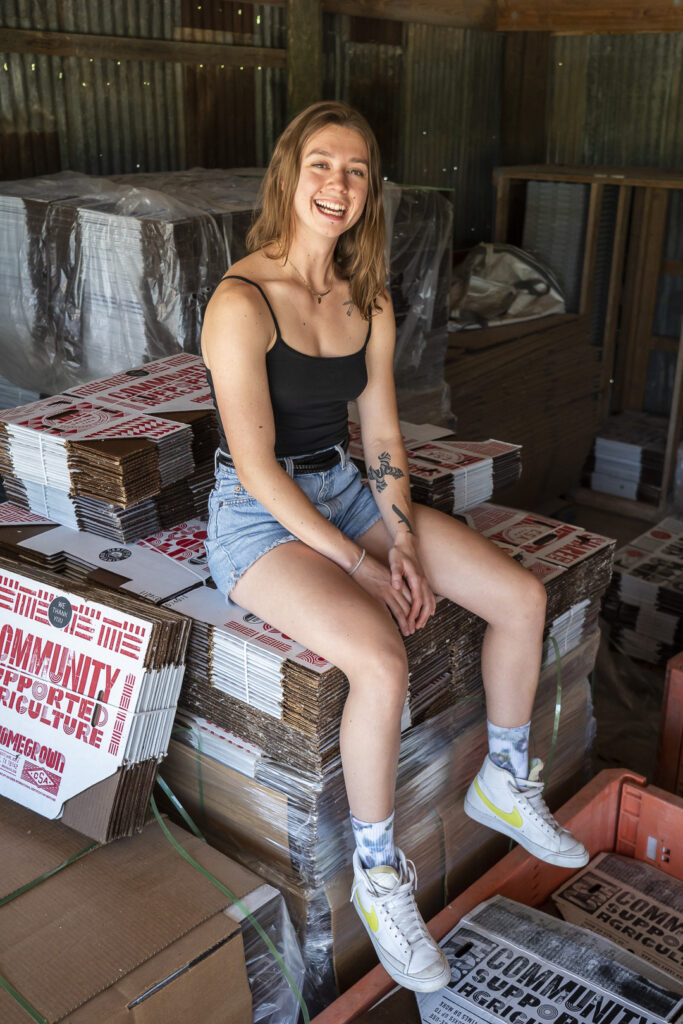 Thanks for all you do, A!
Thanks for all you do, A!
ONION FOCACCIA
05/12/21 — Ada Broussard
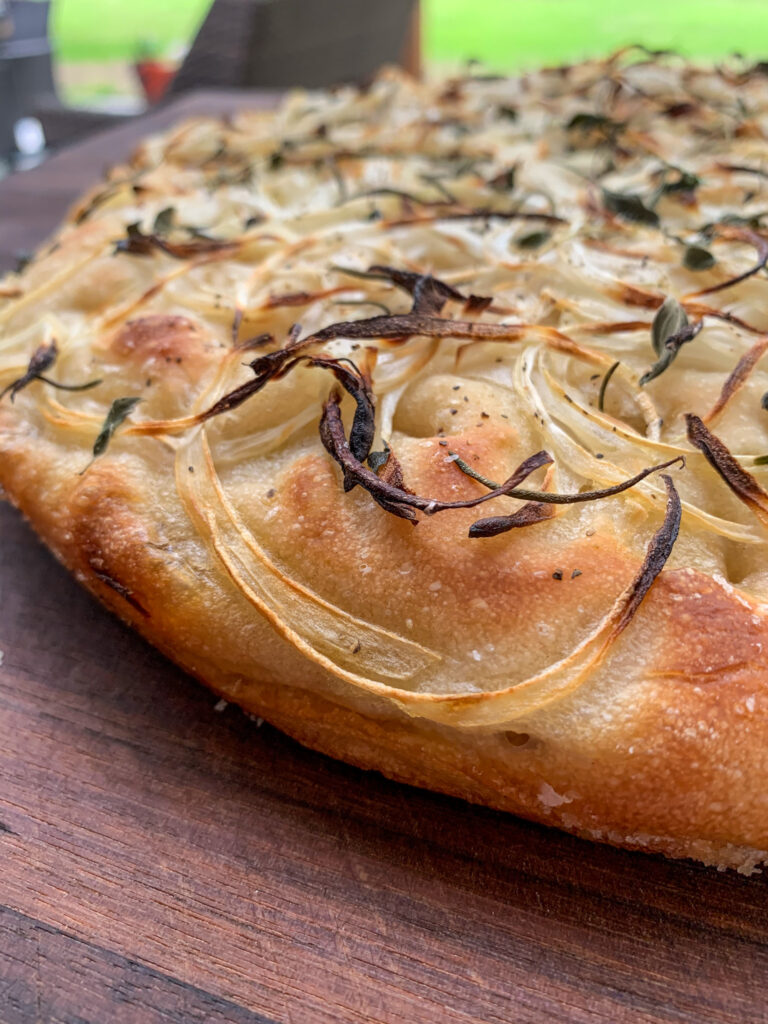 Photo (and focaccia!) by The Migoni Kitchen.
Photo (and focaccia!) by The Migoni Kitchen.
Author: The Migoni Kitchen
We’ve been getting lots of beautiful onions and cook with them all the time but wanted to make something where the onions were the star of the dish. Focaccia is a great beginner bread, so if you’ve never baked bread before it’s a great place to start.
Ingredients:
- 3g - Dry Active Yeast
- 340g - Water
- 500 g - ‘00’ Flour (You can substitute with a 50/50 mixture of bread flour and all-purpose flour)
- 15 g - Kosher Salt plus additional for sprinkling atop the focaccia
- 1 - Medium Onion sliced paper thin
- 2 - large sprigs of fresh herbs (rosemary, oregano, thyme are all great choices)
- Olive Oil
- Black pepper
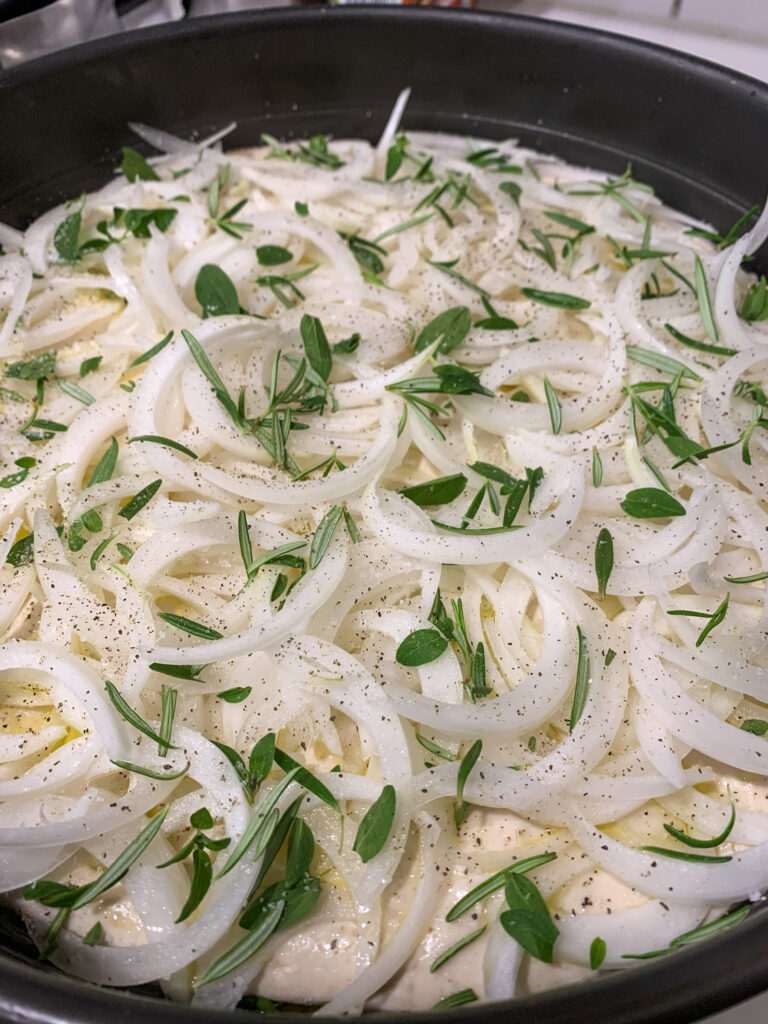 Onions and fresh rosemary and oregano dot the top of this focaccia. Photo by the Migoni Kitchen.
Onions and fresh rosemary and oregano dot the top of this focaccia. Photo by the Migoni Kitchen.
Instructions:
In a large mixing bowl, combine the yeast, water, and 100g of flour. Mix these ingredients until a smooth soupy texture is achieved. Cover with a damp cloth or plastic wrap and let rest for 30 minutes.
Combine the remaining 400g of flour and salt to the mix and begin kneading the dough.
- If mixing by hand, knead the dough on a floured surface for approximately 10 minutes. The dough will be very sticky initially, but will eventually stick to itself forming a large ball. Use additional flour as needed on your hands/surface to help you better form the dough.
- If you are using a stand mixer, use a dough hook and set mixer on level 6 for a minimum of 5 minutes.
Place dough back into the mixing bowl, cover with plastic wrap, and place in a warm place for at least 2 hours.
- Pro-Tip: Place a small glass of water in the microwave and heat it for 3 minutes. This will create a very warm and humid environment in your microwave you can use as a proofing drawer.
Generously drizzle a deep baking pan or cast iron skillet with olive oil. Using a spatula, carefully scrape the bottom of the mixing bowl dumping the dough into the greased pan. Cover with a damp cloth and let rest for 30 minutes in a warm place while you preheat your oven to 500 F.
After you finish the second proof, use your fingers to evenly press into the dough forming the classic indentations throughout.
Next, drizzle the entire focaccia with olive oil being careful to fill each divot. Then, cover the entire focaccia with the onions, add the herbs on top, and finally, sprinkle salt and pepper across the top.
Place focaccia in the oven. After 5 minutes, lower temperature to 450 F and continue baking for 15-20 more minutes. The focaccia is finished when the dough has achieved a deep golden color and the onions have slightly burnt tips.
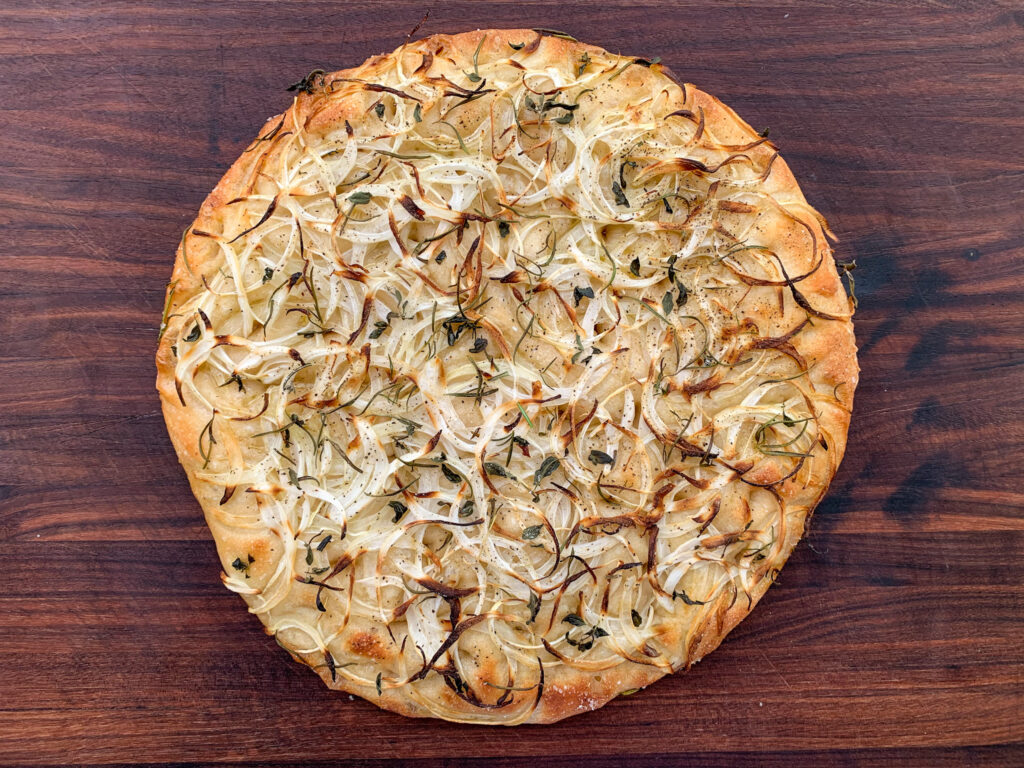 Picture perfect. Photo by The Migoni Kitchen.
Picture perfect. Photo by The Migoni Kitchen.CSA BOX CONTENTS WEEK OF MAY 10TH
05/10/21 — Farm
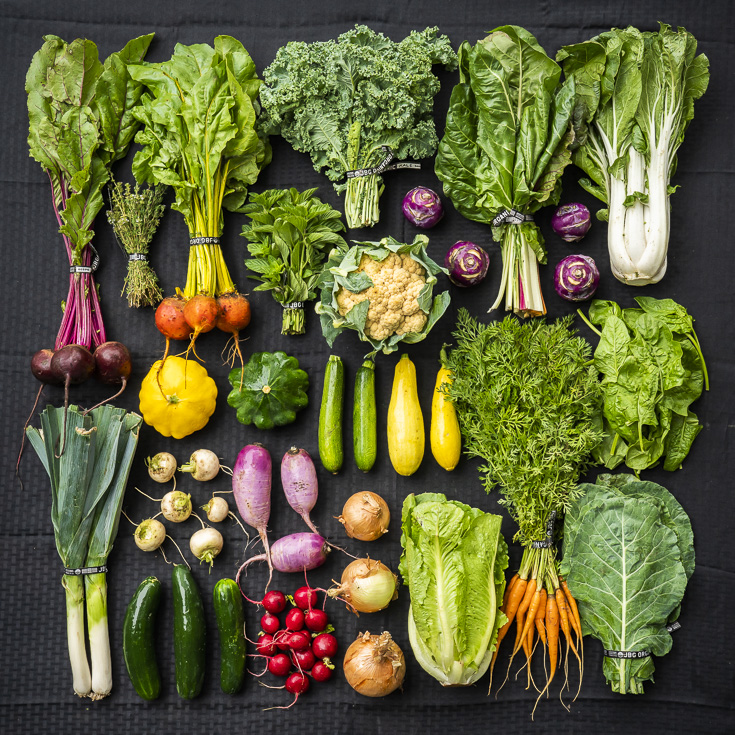 CSA Box Contents Week of May 10th
CSA Box Contents Week of May 10th
Individual: Beet, Carrot, Lettuce, Bok Choy, Kale, Onion
Small: Carrot, Lettuce, Fennel, Collard Greens, Radish, Farmer's Choice Herb, Harvest Highlight, Onion
Medium: Beet, Carrot, Lettuce, Radish, Kale, Farmer's Choice Herb, Harvest Highlight, Kohlrabi, Onion, Chard
Large: Beet, Carrot, Lettuce, Bok Choy, Spinach, Harvest Highlight, Leek, Kohlrabi, Onion, Kale, Chard, Fennel
PHOTOS FROM THE FARM: 5.7.21
05/07/21 — Ada Broussard
Scott visited the farm on a very rainy Tuesday of this week. He got soaked, and it even hailed for a moment! The wet conditions can make for a farm day that is both delightfully difficult, and delightfully exciting. The mud complicates things, but the cool breeze that accompany a rain are a welcome respite. Our vegetables are watered with drip irrigation and so aren't necessarily reliant on rain, but there is no doubting that the environment, overall, shines a little brighter after some rain. Any acreage we have planted in cover crop relies on rainfall to grow, and this week's precipitation certainly helped these plants develop long and branching roots and bigger, bushy foliage. More biomass in our cover crop fields, means more soil protection, and moil organic matter that will break down, food for future carrots.
![]() We trellis our tomatoes using a method called the Florida Weave. A slit is cut in the tomato twine box, and the box gets attached to a belt for easy dispensing. The weave it just what it sounds like. Weave between the stakes, weave between the tomatoes. The figure 8 path holds tension on the growing plants. Photo by Scott David Gordon.
We trellis our tomatoes using a method called the Florida Weave. A slit is cut in the tomato twine box, and the box gets attached to a belt for easy dispensing. The weave it just what it sounds like. Weave between the stakes, weave between the tomatoes. The figure 8 path holds tension on the growing plants. Photo by Scott David Gordon.
![]() After the twine is woven between the tall wooden stakes, it's easiest to use another wooden stake to guide the string back and forth between tomatoes. Photo by Scott David Gordon.
After the twine is woven between the tall wooden stakes, it's easiest to use another wooden stake to guide the string back and forth between tomatoes. Photo by Scott David Gordon.
![]() We will do another row of the Florida weave whenever the tomatoes grow another foot or so. This labor intensive process will not only help grow healthy and strong plants, but it will also help reveal the fruit for easier harvesting. Photo by Scott David Gordon.
We will do another row of the Florida weave whenever the tomatoes grow another foot or so. This labor intensive process will not only help grow healthy and strong plants, but it will also help reveal the fruit for easier harvesting. Photo by Scott David Gordon.
![]() Mud makes everything more difficult. The one task that's maybe a little easier after a downpour? Pounding tomato stakes. Photo by Scott David Gordon.
Mud makes everything more difficult. The one task that's maybe a little easier after a downpour? Pounding tomato stakes. Photo by Scott David Gordon.
![]() The planting must go on. Luckily, we had beds that were prepped before the storm. Photo by Scott David Gordon.
The planting must go on. Luckily, we had beds that were prepped before the storm. Photo by Scott David Gordon.
![]() On a rainy day, the twinkly lights in the lunch barn feel especially magical. Photo by Scott David Gordon.
On a rainy day, the twinkly lights in the lunch barn feel especially magical. Photo by Scott David Gordon.
![]() Aren't our harvest vehicles cute? Photo by Scott David Gordon.
Aren't our harvest vehicles cute? Photo by Scott David Gordon.
![]() Rain or shine, it's harvest time. Photo by Scott David Gordon.
Rain or shine, it's harvest time. Photo by Scott David Gordon.
![]() Jon Mark on the John Deere, under stormy, heavy clouds. Photo by Scott David Gordon.
Jon Mark on the John Deere, under stormy, heavy clouds. Photo by Scott David Gordon.
![]() Farm Manager Jack making a plan with Tractor Operator Jon Mark about what they can quickly get done before the rain descends. Photo by Scott David Gordon.
Farm Manager Jack making a plan with Tractor Operator Jon Mark about what they can quickly get done before the rain descends. Photo by Scott David Gordon.
![]() Tomatoes looking bright, roads looking wet. Photo by Scott David Gordon.
Tomatoes looking bright, roads looking wet. Photo by Scott David Gordon.
![]() Mandatory lunch barn break to wait out the hail. Photo by Scott David Gordon.
Mandatory lunch barn break to wait out the hail. Photo by Scott David Gordon.
![]() Lettuce acting like it aint no thang. Photo by Scott David Gordon.
Lettuce acting like it aint no thang. Photo by Scott David Gordon.
![]() Grilling onions, mostly white, and one purple. Photo by Scott David Gordon.
Grilling onions, mostly white, and one purple. Photo by Scott David Gordon.
![]() The best of both worlds: greens still tender and mild enough to eat, with a hefty enough bulb, worth the slice. Photo by Scott David Gordon.
The best of both worlds: greens still tender and mild enough to eat, with a hefty enough bulb, worth the slice. Photo by Scott David Gordon.
![]() Farmer Tracy filling in on CSA line. Photo by Scott David Gordon.
Farmer Tracy filling in on CSA line. Photo by Scott David Gordon.
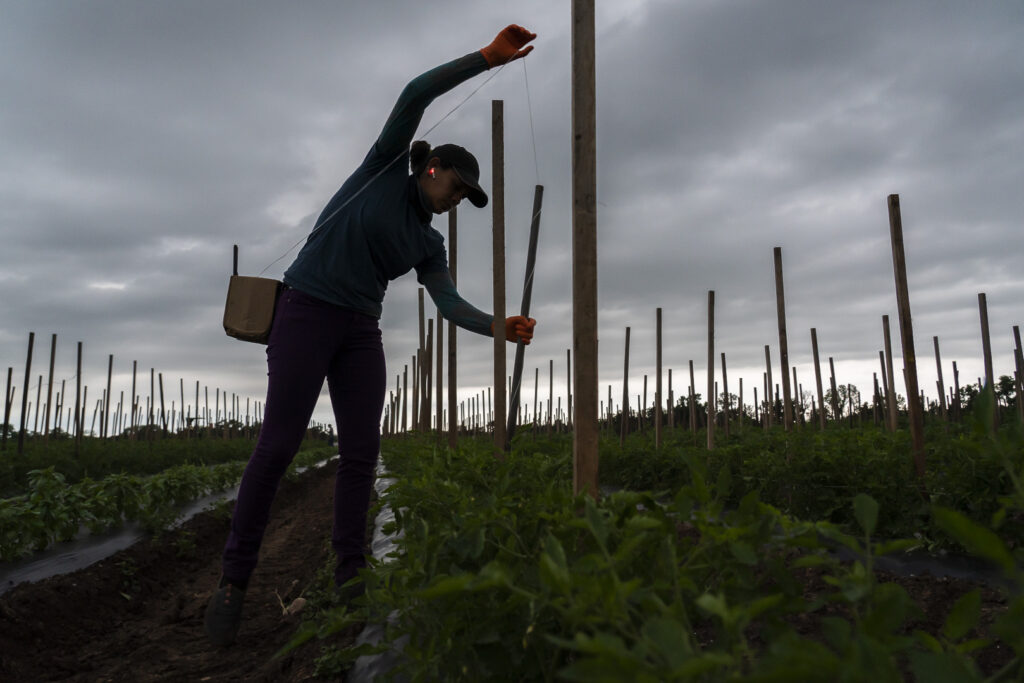 We trellis our tomatoes using a method called the Florida Weave. A slit is cut in the tomato twine box, and the box gets attached to a belt for easy dispensing. The weave it just what it sounds like. Weave between the stakes, weave between the tomatoes. The figure 8 path holds tension on the growing plants. Photo by Scott David Gordon.
We trellis our tomatoes using a method called the Florida Weave. A slit is cut in the tomato twine box, and the box gets attached to a belt for easy dispensing. The weave it just what it sounds like. Weave between the stakes, weave between the tomatoes. The figure 8 path holds tension on the growing plants. Photo by Scott David Gordon.
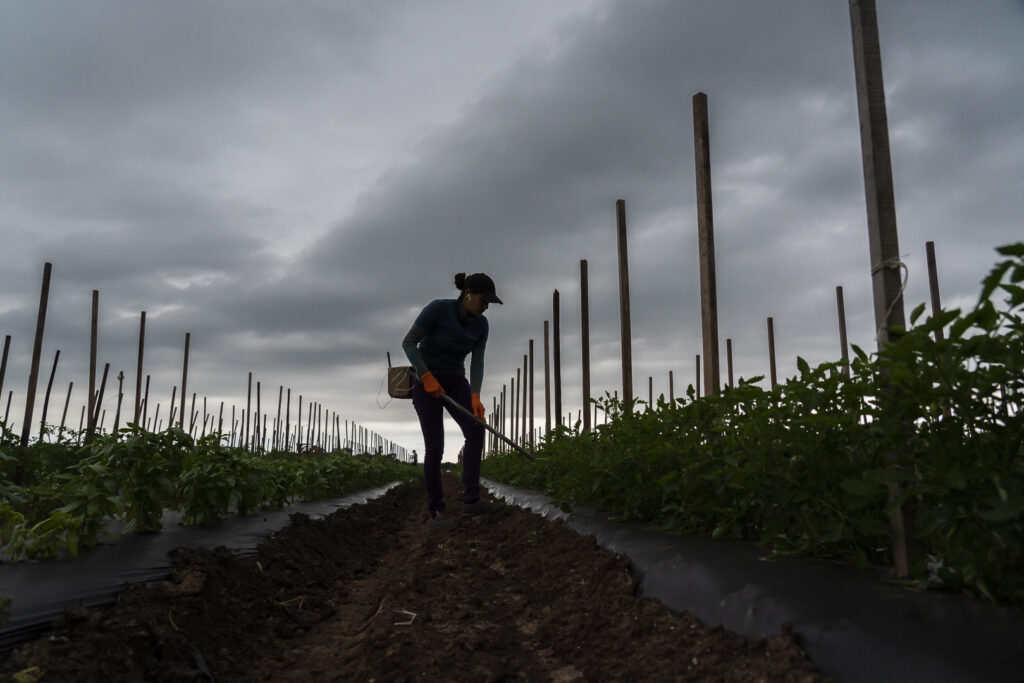 After the twine is woven between the tall wooden stakes, it's easiest to use another wooden stake to guide the string back and forth between tomatoes. Photo by Scott David Gordon.
After the twine is woven between the tall wooden stakes, it's easiest to use another wooden stake to guide the string back and forth between tomatoes. Photo by Scott David Gordon.
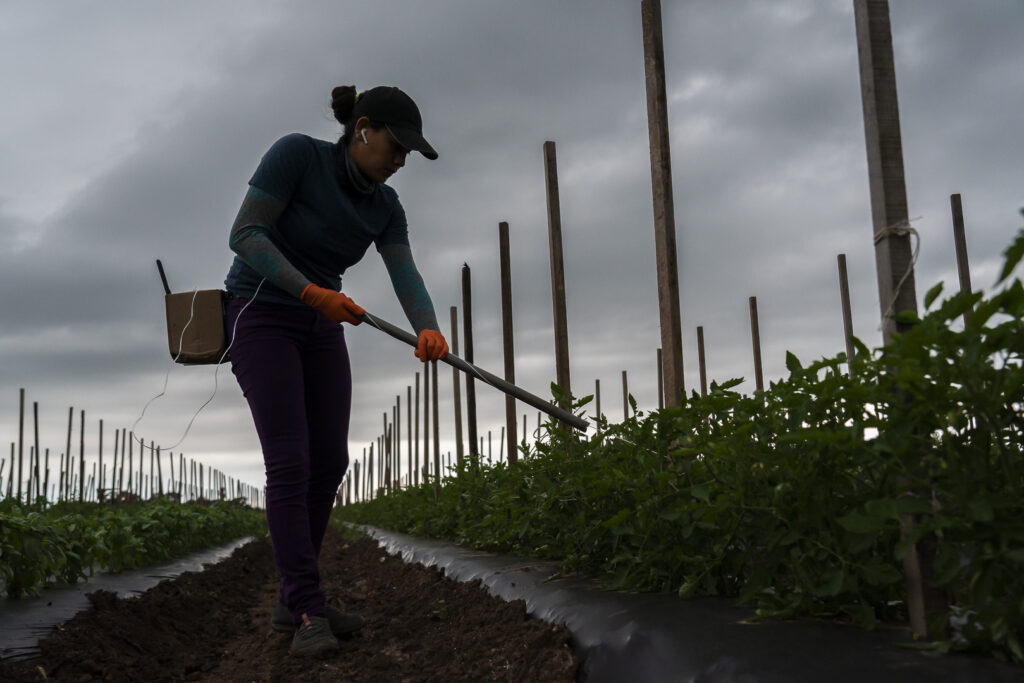 We will do another row of the Florida weave whenever the tomatoes grow another foot or so. This labor intensive process will not only help grow healthy and strong plants, but it will also help reveal the fruit for easier harvesting. Photo by Scott David Gordon.
We will do another row of the Florida weave whenever the tomatoes grow another foot or so. This labor intensive process will not only help grow healthy and strong plants, but it will also help reveal the fruit for easier harvesting. Photo by Scott David Gordon.
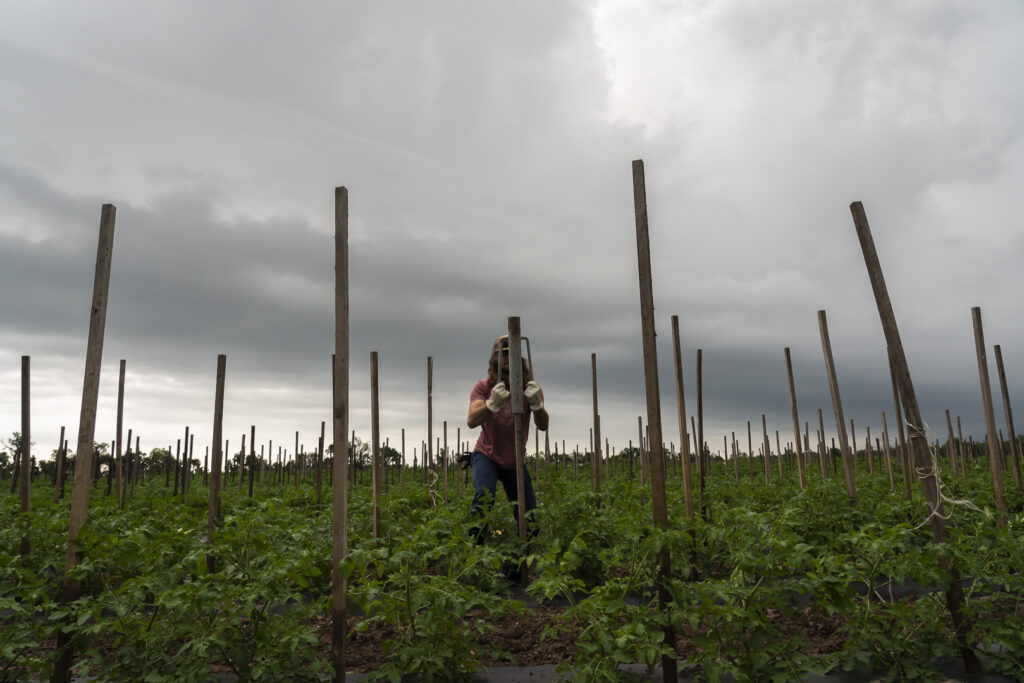 Mud makes everything more difficult. The one task that's maybe a little easier after a downpour? Pounding tomato stakes. Photo by Scott David Gordon.
Mud makes everything more difficult. The one task that's maybe a little easier after a downpour? Pounding tomato stakes. Photo by Scott David Gordon.
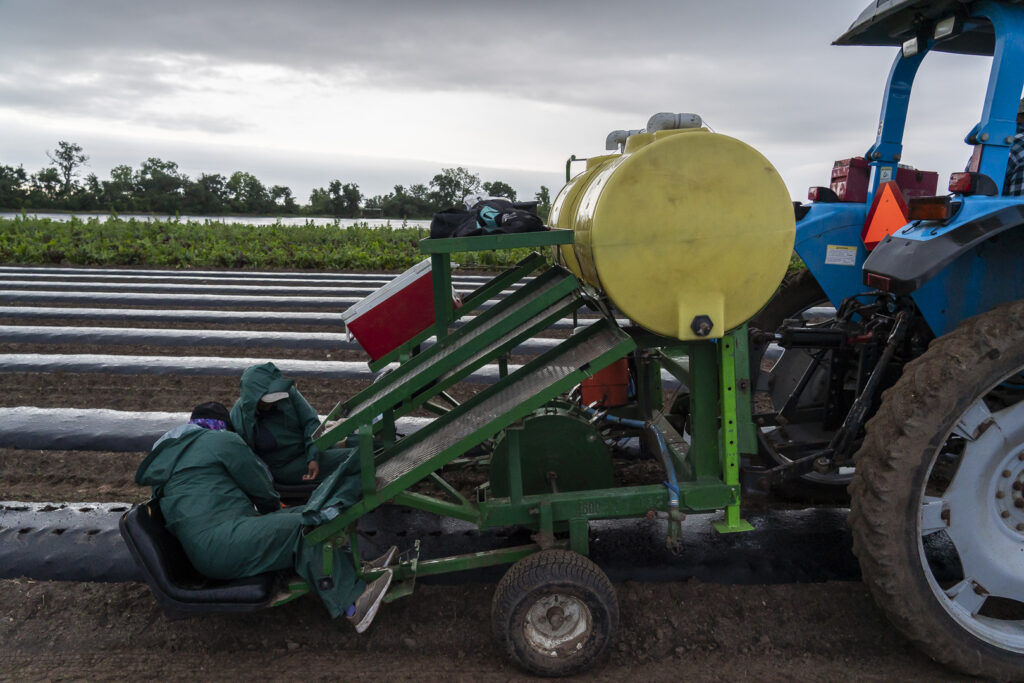 The planting must go on. Luckily, we had beds that were prepped before the storm. Photo by Scott David Gordon.
The planting must go on. Luckily, we had beds that were prepped before the storm. Photo by Scott David Gordon.
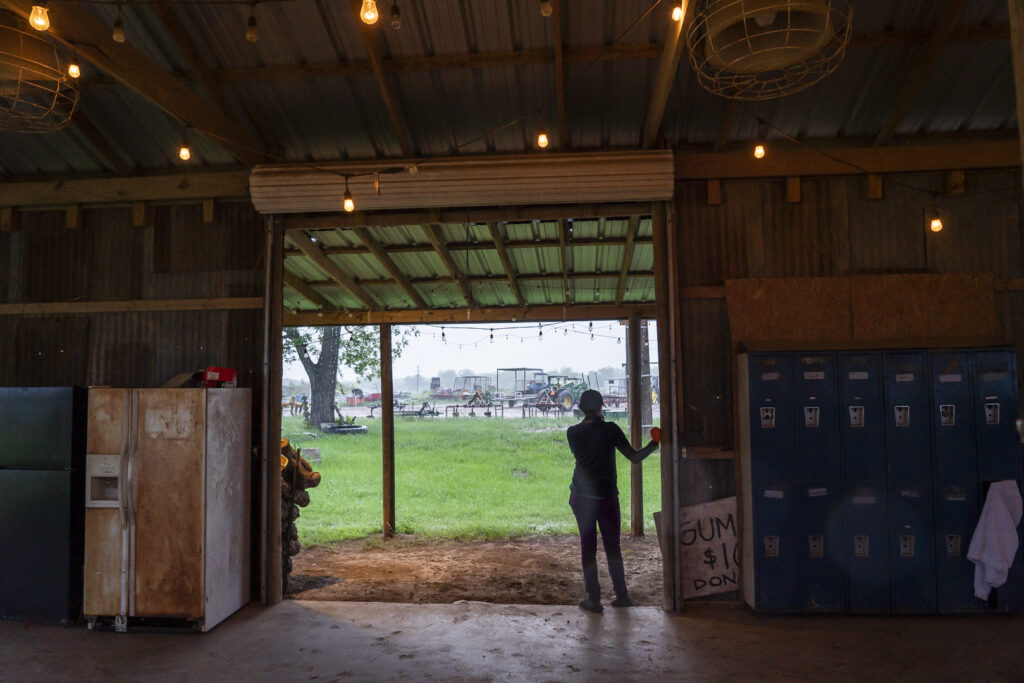 On a rainy day, the twinkly lights in the lunch barn feel especially magical. Photo by Scott David Gordon.
On a rainy day, the twinkly lights in the lunch barn feel especially magical. Photo by Scott David Gordon.
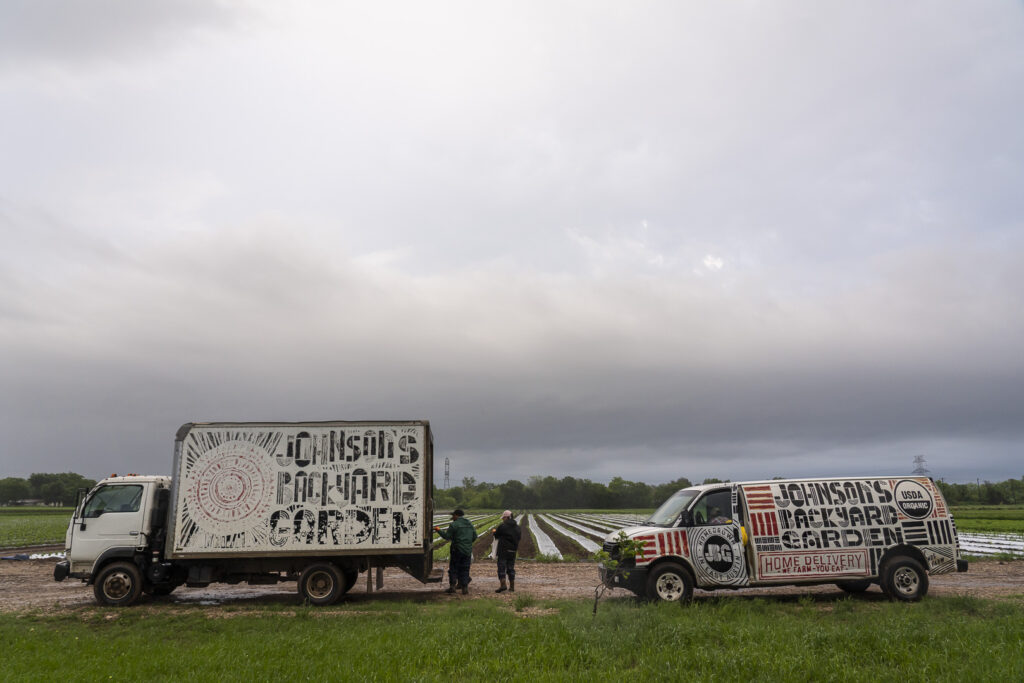 Aren't our harvest vehicles cute? Photo by Scott David Gordon.
Aren't our harvest vehicles cute? Photo by Scott David Gordon.
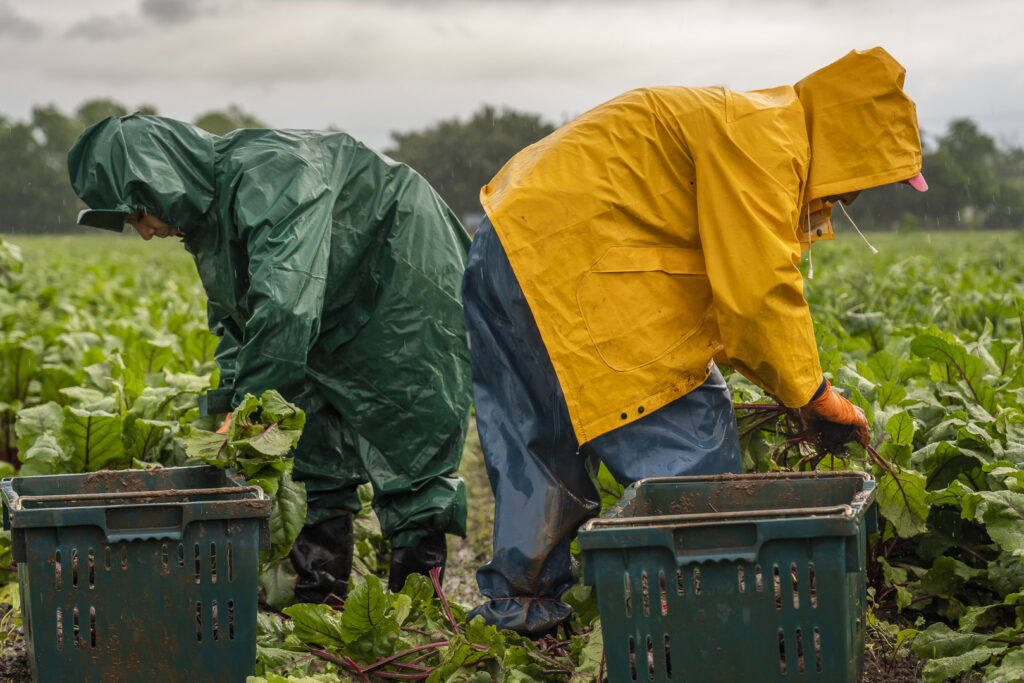 Rain or shine, it's harvest time. Photo by Scott David Gordon.
Rain or shine, it's harvest time. Photo by Scott David Gordon.
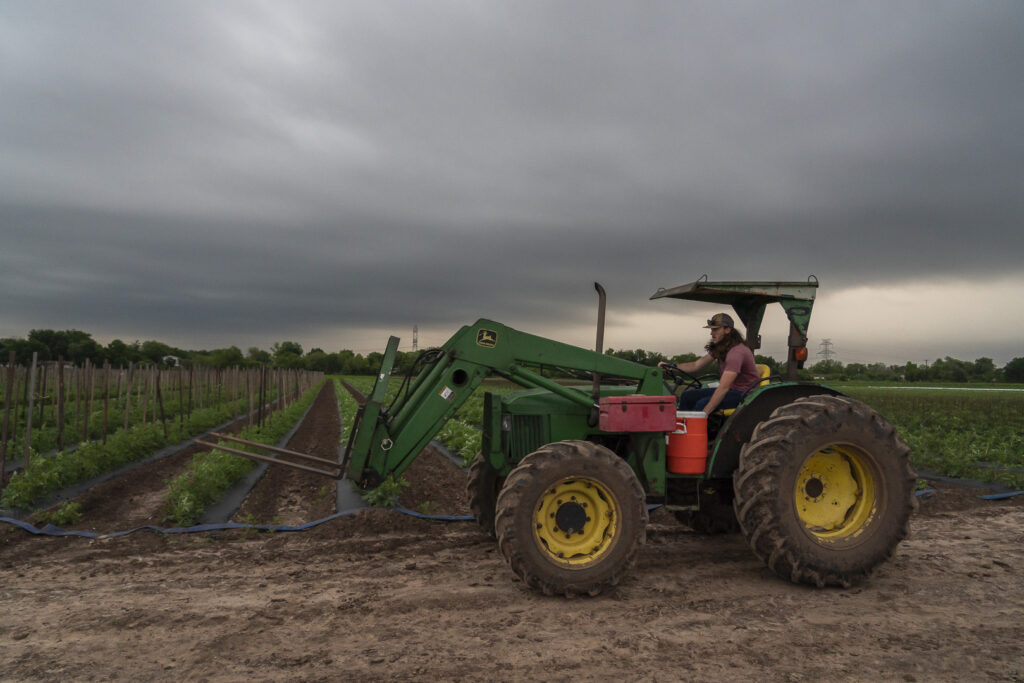 Jon Mark on the John Deere, under stormy, heavy clouds. Photo by Scott David Gordon.
Jon Mark on the John Deere, under stormy, heavy clouds. Photo by Scott David Gordon.
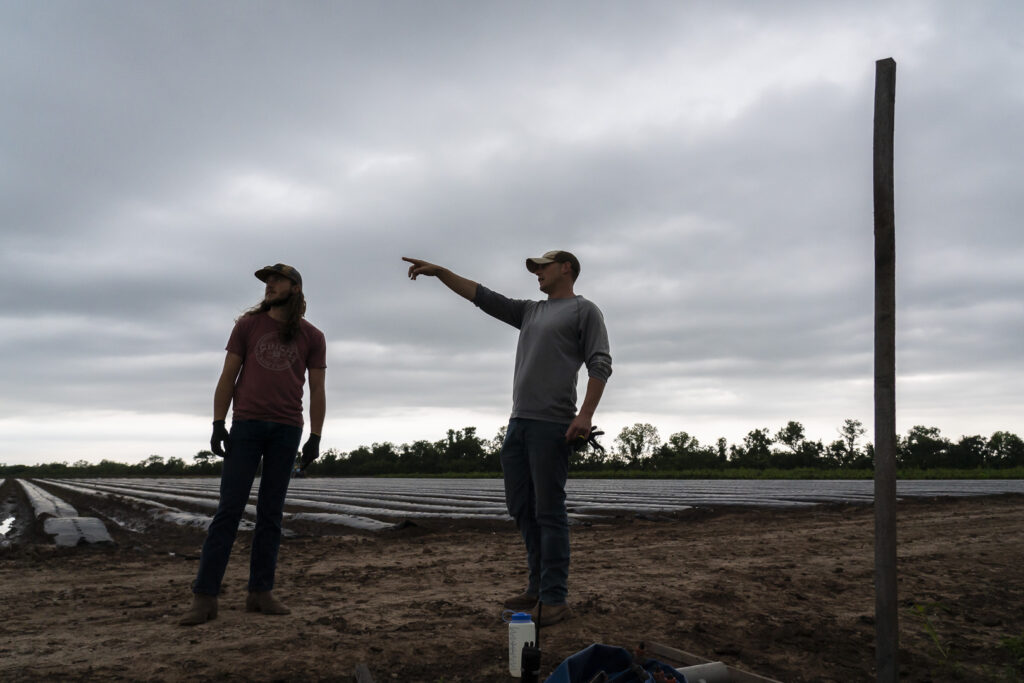 Farm Manager Jack making a plan with Tractor Operator Jon Mark about what they can quickly get done before the rain descends. Photo by Scott David Gordon.
Farm Manager Jack making a plan with Tractor Operator Jon Mark about what they can quickly get done before the rain descends. Photo by Scott David Gordon.
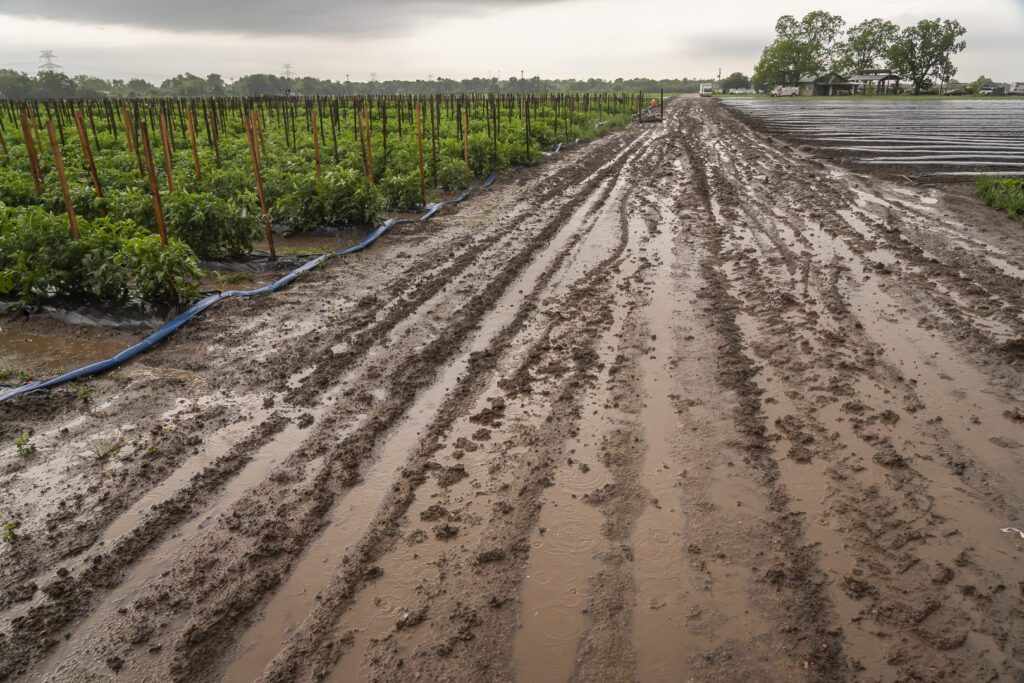 Tomatoes looking bright, roads looking wet. Photo by Scott David Gordon.
Tomatoes looking bright, roads looking wet. Photo by Scott David Gordon.
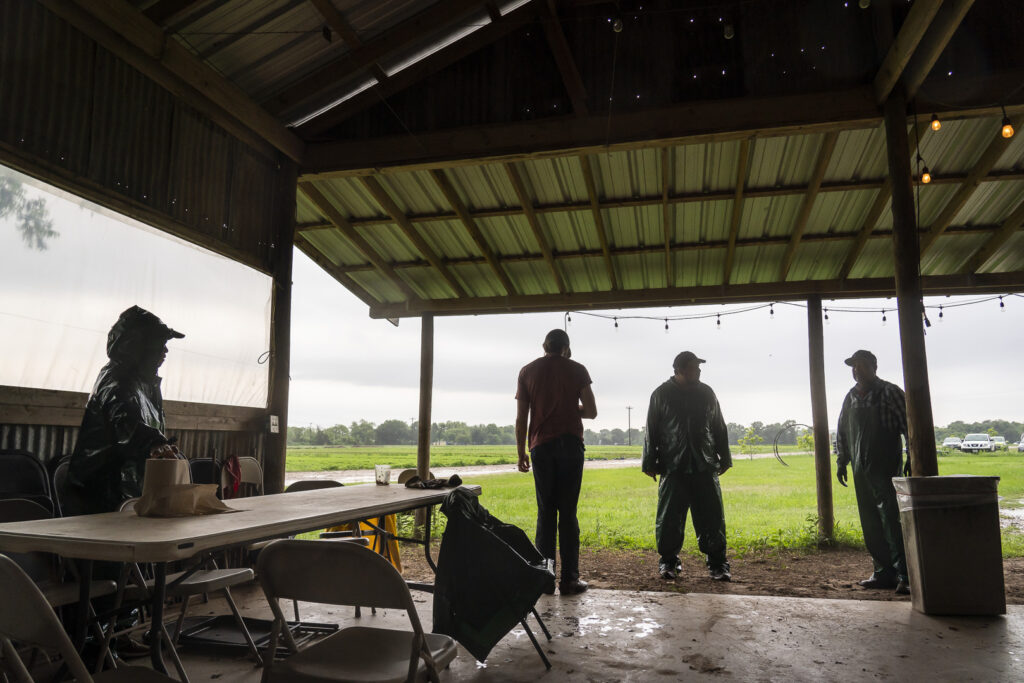 Mandatory lunch barn break to wait out the hail. Photo by Scott David Gordon.
Mandatory lunch barn break to wait out the hail. Photo by Scott David Gordon.
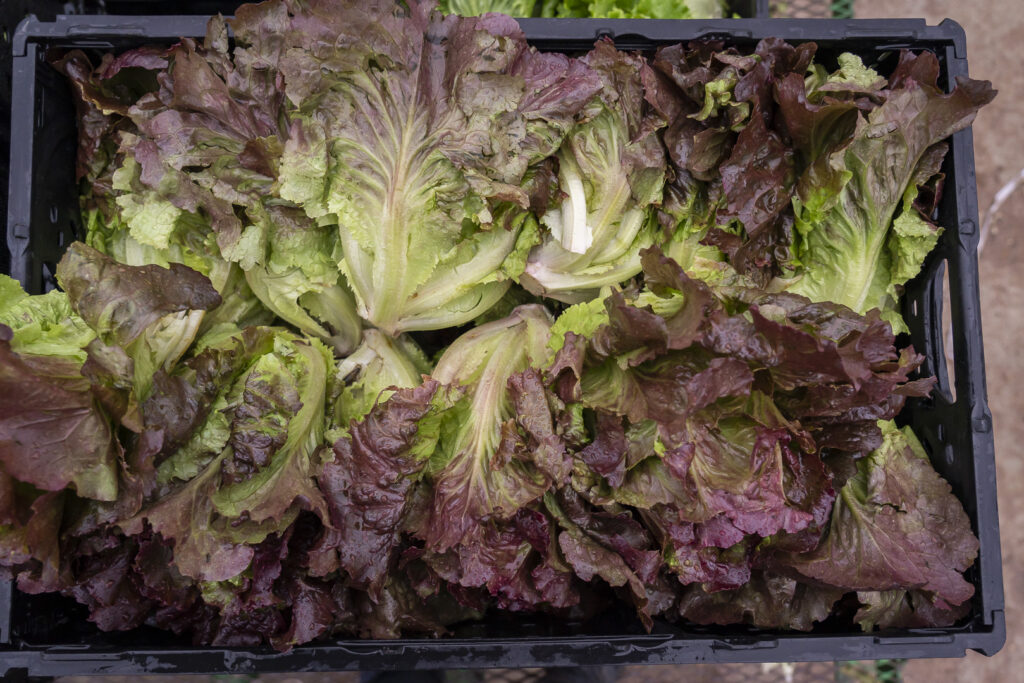 Lettuce acting like it aint no thang. Photo by Scott David Gordon.
Lettuce acting like it aint no thang. Photo by Scott David Gordon.
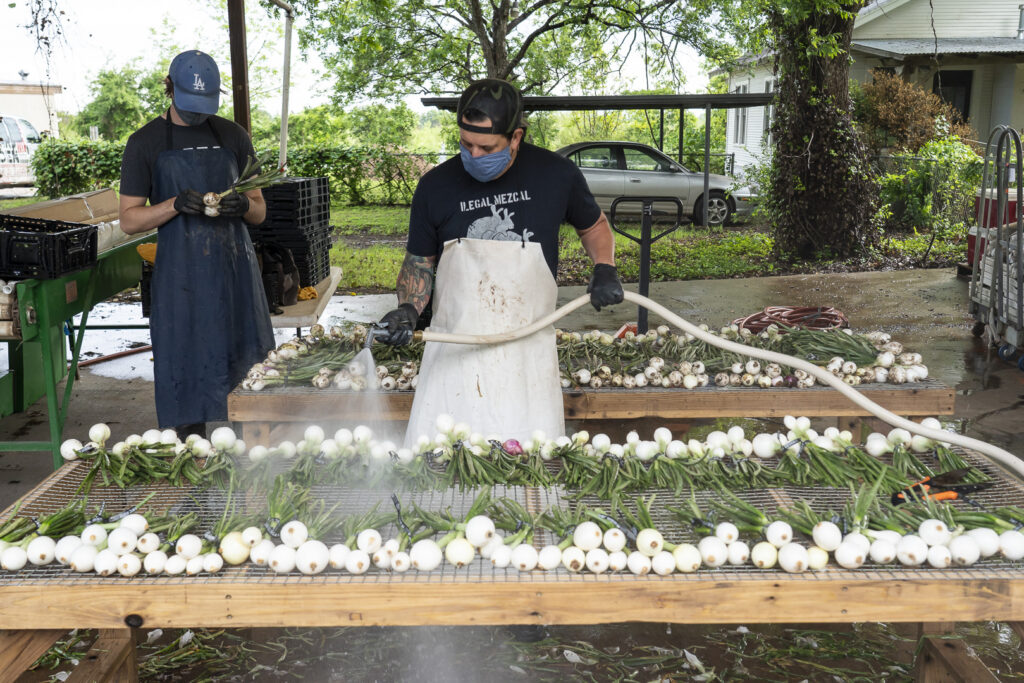 Grilling onions, mostly white, and one purple. Photo by Scott David Gordon.
Grilling onions, mostly white, and one purple. Photo by Scott David Gordon.
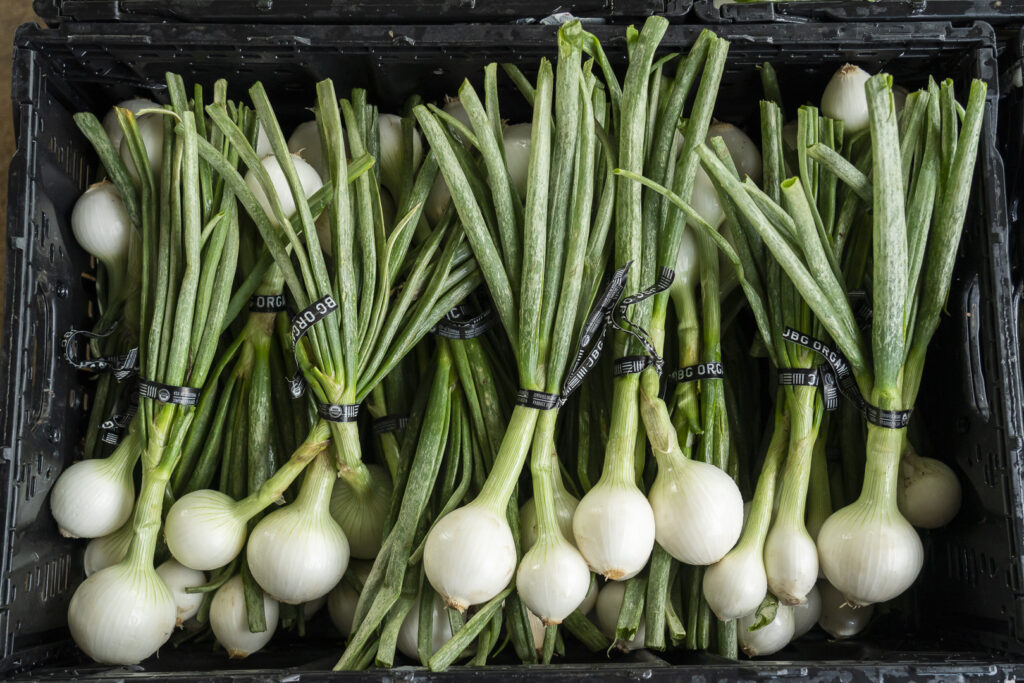 The best of both worlds: greens still tender and mild enough to eat, with a hefty enough bulb, worth the slice. Photo by Scott David Gordon.
The best of both worlds: greens still tender and mild enough to eat, with a hefty enough bulb, worth the slice. Photo by Scott David Gordon.
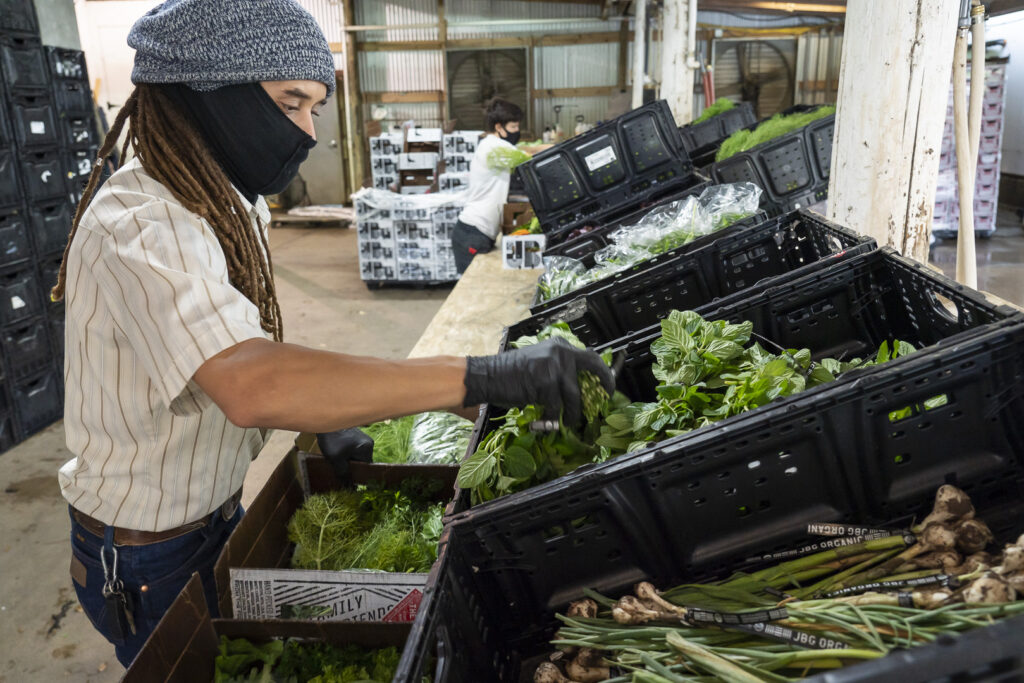 Farmer Tracy filling in on CSA line. Photo by Scott David Gordon.
Farmer Tracy filling in on CSA line. Photo by Scott David Gordon.COMMUNITY SUPPORTED AGRICULTURE IN SAN ANTONIO - DISCOVER THE JOY
05/07/21 — Ada Broussard
This week on the blog, we're hearing from one of our San Antonio CSA Members, Ivette Irizarry. Ivette is a freelance writer specializing in marketing strategy for small business. Thank you Ivette for your thoughtful reflection on your CSA experience! We appreciate it!
![]() Ivette at her pickup location in San Antonio - Merit Coffee!
Ivette at her pickup location in San Antonio - Merit Coffee!
After brief stints in NYC and northern California for grad school, the newly-minted Irizarry party of three landed in San Antonio. The classical violinist, the linguist, and the three-week-old baby were ready to take on the new adventure of learning the Tex-Mex cowboy ways of the Lonestar State.
Needless to say, we fell in love. As the bumper sticker puts it, we weren’t born in Texas, but we got here soon as we could!
(For some more cool ideas about homeschooling with JBG check out this post.)
I wanted my children to know where their food came from. But I knew practically NOTHING about how or what to grow in south-central Texas. Growing up in Puerto Rico, both our dads grew food extensively in our backyards. Plus, my dad always kept chickens. But we were raised growing mangos, papaya, taro root, pineapples, plantains, and pigeon peas. Not exactly the main crops in Texas.
Researching local organic farms and gardening methods I came across the concept of Community Supported Agriculture. I had never heard of such a thing! A friend and I fiddled around with a 6’ x 6’ plot in a community garden back in California, but CSAs were new to me.
Then I remembered that my California friend received a small box of organic produce every week. So I researched community supported agriculture in San Antonio. The more I read about it, the more it intrigued me. When I found JBG Organic, I decided to take the plunge. Community Supported Agriculture has so many benefits!
On delivery day, I walk into the coffee shop and pick up the box with my name on it. When I am a good CSA member — and remember to do so, I bring reusable shopping bags with me so I can transfer my veggie bounty into the bags and leave the box behind to be reused. But, sometimes I forget (see the picture?). Oops! On those days I take the box home and then bring it back to leave at the shop the next time.
![]() Bring your bags, leave your box. And if you forget your bags, no biggie! Just bring the empty box back with your next pickup.
Bring your bags, leave your box. And if you forget your bags, no biggie! Just bring the empty box back with your next pickup.
Beyond Austin and San Antonio, they have pickup locations in Dallas, Houston, and six other cities. No matter where you live you can get fresh organic produce, and compared to most grocery store produce that is being shipped from across the country, or even across the globe, JBG veggies get to you while they’re very fresh!.
You open the box and, SURPRISE!! My favorite is when I find things I have never eaten or even seen before. That happened a lot the first year. It was so cool to pick something up and wonder, “What in the world is this, and how do I eat it?” I was completely unfamiliar with sweet potato greens. Other puzzling finds included amaranth, rutabaga, and romanesco. The battle cry became, “I don’t know what this is but we’re going to eat it!”
Now, full disclosure, we are not seasonal Nazis in the Irizarry household. We do also buy some produce that is not local or in season here in Texas but we have certainly changed the way we eat to be mostly seasonal. The convenience of having the produce delivered regularly makes it a no brainer. I don’t have to keep track of what is in season. It just comes to me. And we are always looking for ways we can preserve some of that produce (canning, freezing, drying) so we can use it out of season.
The best thing is that what grows together goes together. So it is a lot of fun to open up our CSA share box and start to figure out flavor combinations using multiple items.
I grew up in Puerto Rico, a tropical island in the Caribbean that is politically a US Territory. As part of the Spanish-speaking Caribbean, its culture and cuisine are very different from what we experience in Texas. It is also very distinct from the more familiar Mexican cuisine we know and love in the Lonestar state. Our food is closer to that found in Cuba and the Dominican Republic, with heavy influences from Spain and the African regions of the slaves they brought to the island.
The key for us has been not to get hung up on strict authenticity so we can let our Texas produce shine when we give it a Caribbean treatment. It makes for really fun food adventures. I’ll share a couple of them with you.
The foundation of most cuisines is based on a specific combination of aromatics. In Puerto Rico, we call that ‘sofrito.’ Puerto Rican sofrito uses mostly common veggies and herbs. The one distinctive herb that is not widely grown in Texas is recao, also known as culantro or spiny cilantro. I mean, if farmer Brenton would like to start growing it… hint, hint, big wink, puppy eyes, pleading look. — In the meantime, we substitute delicious JBG cilantro. (But, seriously, farmer Brenton, I can hook you up with some seeds)
Here is what I made with my frozen TexiRican sofrito and some beautiful swiss chard that came in a recent CSA share.
![]() Ivette's Acelgas Guisadas is a perfect recipe for any green that shows up in your CSA box - kale, collards, spinach, or even summer staples like amaranth or sweet potato greens. Photos by Ivette!
Ivette's Acelgas Guisadas is a perfect recipe for any green that shows up in your CSA box - kale, collards, spinach, or even summer staples like amaranth or sweet potato greens. Photos by Ivette!
Puerto Rican Stewed Swiss Chard *Recipe adapted from Cocine a Gusto the classic Puerto Rican cookbook I inherited from my mother… but that’s a whole-nother blog...
My mom’s cookbook says to serve while it’s hot, and to add 3 beaten eggs. Honestly, this would be great over rice, with pasta, over mashed potatoes, on grits, inside your favorite tortilla or flatbread, on a piece of crusty sourdough. Basically, have greens, add carbs.
Instead of mixing in the scrambled eggs, I chose to serve them alongside, with a couple of Export Sodas, a Puerto Rican staple saltine cracker. ¡Qué rico!
What have YOU learned since you started eating seasonally? Have you joined the JBG CSA? What is stopping you? I would love to know. Leave me your comments below.
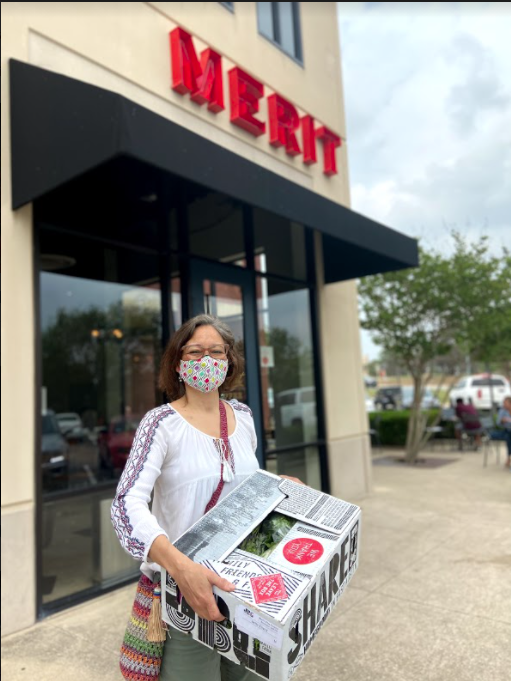 Ivette at her pickup location in San Antonio - Merit Coffee!
Ivette at her pickup location in San Antonio - Merit Coffee!
How I CSA — Over Here In SA
Searching for Community Supported Agriculture near me I found Johnson’s Backyard Garden. Becoming a CSA member has been one of my favorite experiences since I moved to San Antonio, Texas.After brief stints in NYC and northern California for grad school, the newly-minted Irizarry party of three landed in San Antonio. The classical violinist, the linguist, and the three-week-old baby were ready to take on the new adventure of learning the Tex-Mex cowboy ways of the Lonestar State.
Needless to say, we fell in love. As the bumper sticker puts it, we weren’t born in Texas, but we got here soon as we could!
Why join a CSA?
Finally having a backyard —impossible in Manhattan, and cost-prohibitive in California— gave us the opportunity to dig into organic gardening. At that point, I was homeschooling two kiddos and was looking for ways to enrich their education beyond academics.(For some more cool ideas about homeschooling with JBG check out this post.)
I wanted my children to know where their food came from. But I knew practically NOTHING about how or what to grow in south-central Texas. Growing up in Puerto Rico, both our dads grew food extensively in our backyards. Plus, my dad always kept chickens. But we were raised growing mangos, papaya, taro root, pineapples, plantains, and pigeon peas. Not exactly the main crops in Texas.
Researching local organic farms and gardening methods I came across the concept of Community Supported Agriculture. I had never heard of such a thing! A friend and I fiddled around with a 6’ x 6’ plot in a community garden back in California, but CSAs were new to me.
Then I remembered that my California friend received a small box of organic produce every week. So I researched community supported agriculture in San Antonio. The more I read about it, the more it intrigued me. When I found JBG Organic, I decided to take the plunge. Community Supported Agriculture has so many benefits!
- Eating fresh organic produce that is grown following sustainable practices
- Eating seasonal fruits and veggies at the peak of their taste and nutrition
- Becoming part of a greater community pursuing healthy living
- Supporting the livelihood of local farmers and their employees
- Getting the first pick of the crop, set aside for CSA members
Getting Your CSA Share Box is So Easy!
At first, when I found JBG Organic and saw they were based in Austin I was a little worried. I know it’s only an hour away, but how would they make this happen? Turns out getting my CSA share is a breeze. All I had to do was select a location near me where my box would be delivered. I chose the Merit Coffee Shop in the Stone Oak area.On delivery day, I walk into the coffee shop and pick up the box with my name on it. When I am a good CSA member — and remember to do so, I bring reusable shopping bags with me so I can transfer my veggie bounty into the bags and leave the box behind to be reused. But, sometimes I forget (see the picture?). Oops! On those days I take the box home and then bring it back to leave at the shop the next time.
 Bring your bags, leave your box. And if you forget your bags, no biggie! Just bring the empty box back with your next pickup.
Bring your bags, leave your box. And if you forget your bags, no biggie! Just bring the empty box back with your next pickup.
Beyond Austin and San Antonio, they have pickup locations in Dallas, Houston, and six other cities. No matter where you live you can get fresh organic produce, and compared to most grocery store produce that is being shipped from across the country, or even across the globe, JBG veggies get to you while they’re very fresh!.
Every Week a Birthday!
Do you remember the joy of opening up a present on your birthday? Especially when it was a surprise that you didn’t expect. Oh, the wonder! Well, you can capture that feeling every week with a CSA subscription. Okay, okay, so I actually have the every-other-week subscription, but you get it.You open the box and, SURPRISE!! My favorite is when I find things I have never eaten or even seen before. That happened a lot the first year. It was so cool to pick something up and wonder, “What in the world is this, and how do I eat it?” I was completely unfamiliar with sweet potato greens. Other puzzling finds included amaranth, rutabaga, and romanesco. The battle cry became, “I don’t know what this is but we’re going to eat it!”
Eating Seasonally
Before, we were used to finding ALL THE THINGS in the supermarket all year round. But our own backyard gardening experiments, along with our CSA membership introduced us to the concept of eating seasonally. Fruits and veggies that are in season have a much higher nutritional value, and are at the peak of their flavor. Eating locally-grown seasonal produce is also better for the environment since it minimizes the distance the food has to travel to get to us. And it is better for our community because we support the work of our local farmers.Now, full disclosure, we are not seasonal Nazis in the Irizarry household. We do also buy some produce that is not local or in season here in Texas but we have certainly changed the way we eat to be mostly seasonal. The convenience of having the produce delivered regularly makes it a no brainer. I don’t have to keep track of what is in season. It just comes to me. And we are always looking for ways we can preserve some of that produce (canning, freezing, drying) so we can use it out of season.
The best thing is that what grows together goes together. So it is a lot of fun to open up our CSA share box and start to figure out flavor combinations using multiple items.
Expanding Tastebuds and Creativity
Our CSA membership has opened our eyes (and mouths) to new possibilities in what we eat. And we have enjoyed finding creative ways to use Texas produce adapted into dishes from our own cultural heritage.I grew up in Puerto Rico, a tropical island in the Caribbean that is politically a US Territory. As part of the Spanish-speaking Caribbean, its culture and cuisine are very different from what we experience in Texas. It is also very distinct from the more familiar Mexican cuisine we know and love in the Lonestar state. Our food is closer to that found in Cuba and the Dominican Republic, with heavy influences from Spain and the African regions of the slaves they brought to the island.
The key for us has been not to get hung up on strict authenticity so we can let our Texas produce shine when we give it a Caribbean treatment. It makes for really fun food adventures. I’ll share a couple of them with you.
The foundation of most cuisines is based on a specific combination of aromatics. In Puerto Rico, we call that ‘sofrito.’ Puerto Rican sofrito uses mostly common veggies and herbs. The one distinctive herb that is not widely grown in Texas is recao, also known as culantro or spiny cilantro. I mean, if farmer Brenton would like to start growing it… hint, hint, big wink, puppy eyes, pleading look. — In the meantime, we substitute delicious JBG cilantro. (But, seriously, farmer Brenton, I can hook you up with some seeds)
TexiRican Sofrito
- 1 large onion (or 2 small)
- 3 garlic cloves
- 1 bunch cilantro
- 1 sweet pepper (any kind that came in the share)
- 1 tsp. dried oregano (or 2 tsp. fresh)
- 1 Tbsp. olive oil or your choice of liquid oil (optional)
- Salt and black pepper to taste
Here is what I made with my frozen TexiRican sofrito and some beautiful swiss chard that came in a recent CSA share.
Acelgas Guisadas
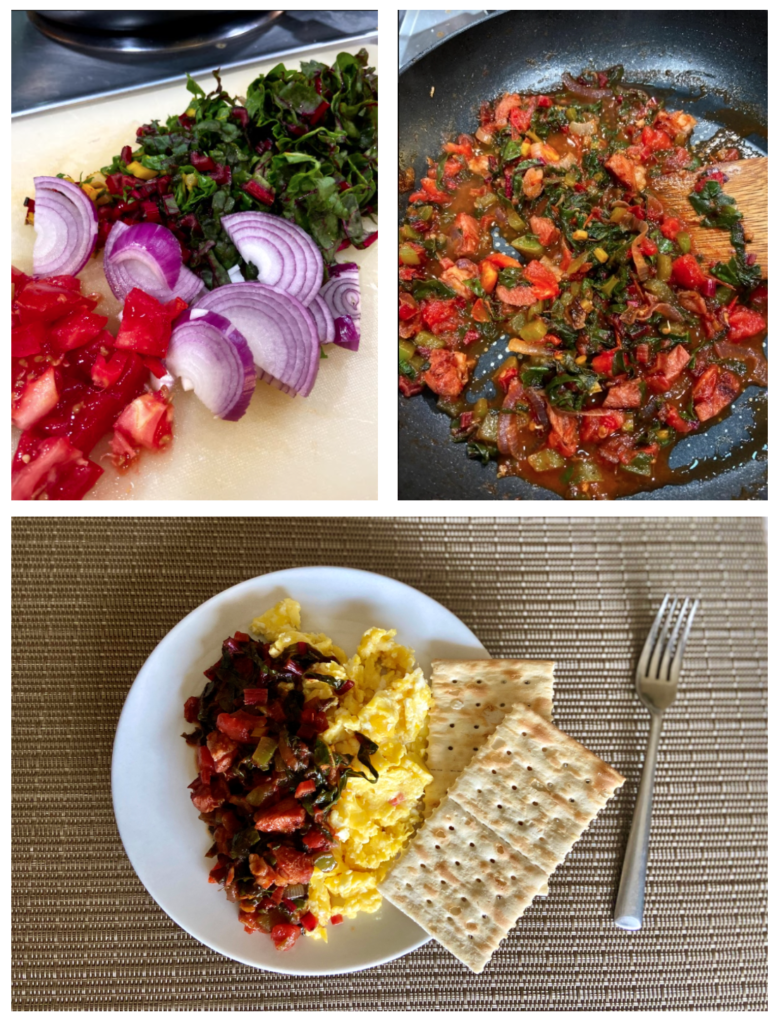 Ivette's Acelgas Guisadas is a perfect recipe for any green that shows up in your CSA box - kale, collards, spinach, or even summer staples like amaranth or sweet potato greens. Photos by Ivette!
Ivette's Acelgas Guisadas is a perfect recipe for any green that shows up in your CSA box - kale, collards, spinach, or even summer staples like amaranth or sweet potato greens. Photos by Ivette!
Puerto Rican Stewed Swiss Chard *Recipe adapted from Cocine a Gusto the classic Puerto Rican cookbook I inherited from my mother… but that’s a whole-nother blog...
- 1 bunch swiss chard (or any other sturdy green you found in the box: collard, turnip, beet, kale, etc.)
- 1 Tbsp. oil of your choice
- 1 onion, diced (or in the size and shape of your choice)
- 1 pepper, diced (or in the size and shape of your choice)
- 2 oz. ham, bacon, smoked meat or meat substitute of choice (optional)
- 2 Tbsp. TexiRican Sofrito (1 cube)
- 2 tomatoes, chopped (fresh or canned)
- 1 cup water or broth
- 1 tsp. Salt, or to taste
My mom’s cookbook says to serve while it’s hot, and to add 3 beaten eggs. Honestly, this would be great over rice, with pasta, over mashed potatoes, on grits, inside your favorite tortilla or flatbread, on a piece of crusty sourdough. Basically, have greens, add carbs.
Instead of mixing in the scrambled eggs, I chose to serve them alongside, with a couple of Export Sodas, a Puerto Rican staple saltine cracker. ¡Qué rico!
What have YOU learned since you started eating seasonally? Have you joined the JBG CSA? What is stopping you? I would love to know. Leave me your comments below.
CSA BOX CONTENTS WEEK OF MAY 3RD
04/30/21 — Farm
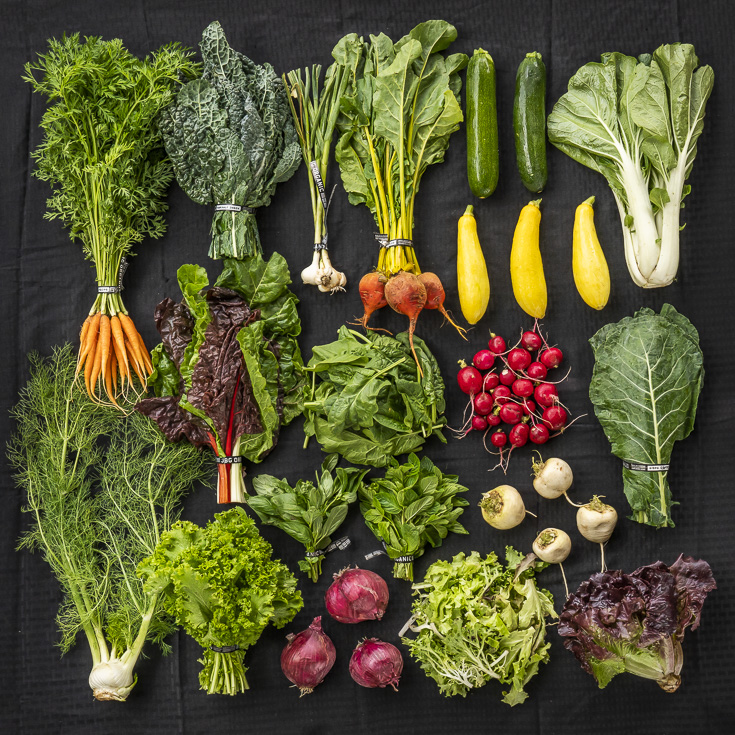 CSA Box Contents Week of May 3rd
CSA Box Contents Week of May 3rd
individual: Golden Beet, Red Radish, Spinach, Farmer's Choice Herb, Collard Greens, Onion
Small: Golden Beet, Bok Choy, White Japanese Turnip, Onion, Arugula, Chard, Mustard Greens
Medium: Carrot, Red Beet, Red Radish, Green Garlic, Farmer's Choice Lettuce, Spinach, Onion, Fennel, Famer's Choice, Herb, Collard Greens
Large: Carrots, Red Beet, Bok Choy, Green Garlic, Spinach, Fennel, Salad Greens, Kale, Farmer's Choice, Chard, Farmer's Choice Herb
KALE AND PARSLEY PESTO WITH PRESERVED LEMON
04/30/21 — Ada Broussard

Recipe and Photos by Mackenzie Smith
We are aiming for a mostly plant-based diet this month, and some version of this nutty pesto has been showing up on our table every week since the beginning of the year, slathered on toast, as a dip for veggies and chips, and a sauce for pasta. Swap hempseeds and pecans for your favorite nut (pepitas, walnuts, and almonds are also great here), and if you don’t have preserved lemon on hand, use the zest and juice of one lemon instead.
- 1 bunch of kale, spine removed and roughly chopped
- 1 bunch of parsley, roughly chopped
- A generous handful of dill, roughly chopped
- 2 cloves of garlic
- 1/4 cup pecans
- 1/4 cup hempseed
- 1 preserved lemon, seeds removed
- ⅓ - ½ cup olive oil
- 1/4 cup water (more if needed)
- salt to taste
Mix in a food processor for a chunkier paste, or a blender for a very smooth one like the one pictured here.






 0 ITEMS IN CART
0 ITEMS IN CART 

